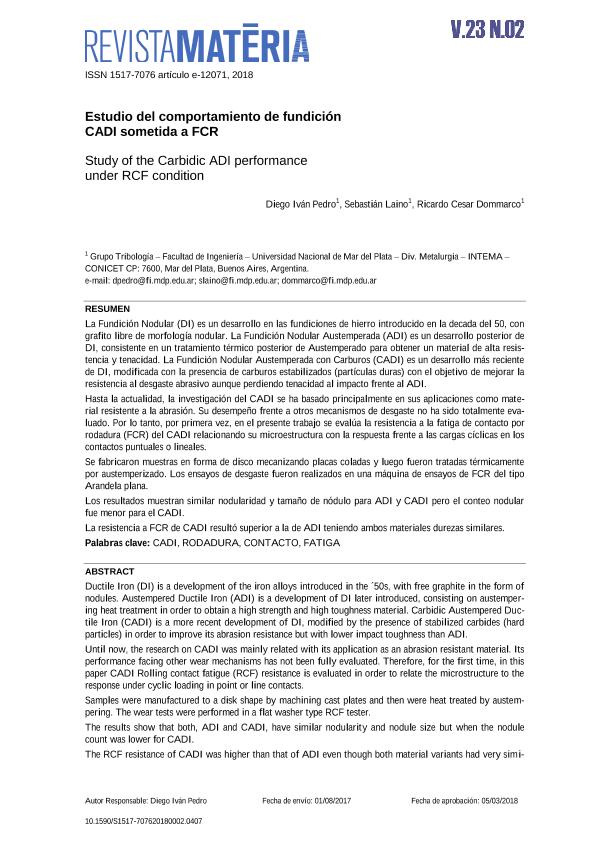Artículo
La Fundición Nodular (DI) es un desarrollo en las fundiciones de hierro introducido en la decada del 50, con grafito libre de morfología nodular. La Fundición Nodular Austemperada (ADI) es un desarrollo posterior de DI, consistente en un tratamiento térmico posterior de Austemperado para obtener un material de alta resistencia y tenacidad. La Fundición Nodular Austemperada con Carburos (CADI) es un desarrollo más reciente de DI, modificada con la presencia de carburos estabilizados (partículas duras) con el objetivo de mejorar la resistencia al desgaste abrasivo aunque perdiendo tenacidad al impacto frente al ADI. Hasta la actualidad, la investigación del CADI se ha basado principalmente en sus aplicaciones como material resistente a la abrasión. Su desempeño frente a otros mecanismos de desgaste no ha sido totalmente evaluado. Por lo tanto, por primera vez, en el presente trabajo se evalúa la resistencia a la fatiga de contacto por rodadura (FCR) del CADI relacionando su microestructura con la respuesta frente a las cargas cíclicas en los contactos puntuales o lineales. Se fabricaron muestras en forma de disco mecanizando placas coladas y luego fueron tratadas térmicamente por austemperizado. Los ensayos de desgaste fueron realizados en una máquina de ensayos de FCR del tipo Arandela plana. Los resultados muestran similar nodularidad y tamaño de nódulo para ADI y CADI pero el conteo nodular fue menor para el CADI. La resistencia a FCR de CADI resultó superior a la de ADI teniendo ambos materiales durezas similares. Ductile Iron (DI) is a development of the iron alloys introduced in the ´50s, with free graphite in the form of nodules. Austempered Ductile Iron (ADI) is a development of DI later introduced, consisting on austempering heat treatment in order to obtain a high strength and high toughness material. Carbidic Austempered Ductile Iron (CADI) is a more recent development of DI, modified by the presence of stabilized carbides (hard particles) in order to improve its abrasion resistance but with lower impact toughness than ADI.Until now, the research on CADI was mainly related with its application as an abrasion resistant material. Its performance facing other wear mechanisms has not been fully evaluated. Therefore, for the first time, in this paper CADI Rolling contact fatigue (RCF) resistance is evaluated in order to relate the microstructure to the response under cyclic loading in point or line contacts.Samples were manufactured to a disk shape by machining cast plates and then were heat treated by austempering. The wear tests were performed in a flat washer type RCF tester.The results show that both, ADI and CADI, have similar nodularity and nodule size but when the nodule count was lower for CADI.The RCF resistance of CADI was higher than that of ADI even though both material variants had very similar hardness.
Estudio del comportamiento de fundicion CADI sometida a FCR
Título:
Study of the Carbidic ADI performance under RCF condition
Fecha de publicación:
07/2018
Editorial:
Universidade Federal do Rio de Janeiro
Revista:
Matéria
ISSN:
1517-7076
Idioma:
Español
Tipo de recurso:
Artículo publicado
Clasificación temática:
Resumen
Archivos asociados
Licencia
Identificadores
Colecciones
Articulos(INTEMA)
Articulos de INST.DE INV.EN CIENCIA Y TECNOL.MATERIALES (I)
Articulos de INST.DE INV.EN CIENCIA Y TECNOL.MATERIALES (I)
Citación
Pedro, Diego Iván; Laino, Sebastian; Dommarco, Ricardo; Estudio del comportamiento de fundicion CADI sometida a FCR; Universidade Federal do Rio de Janeiro; Matéria; 23; 2; 7-2018
Compartir
Altmétricas




